2003 Hyundai Santa Fe fuse box
[x] Cancel search: fuse boxPage 172 of 221

6- 2 DO-IT-YOURSELF MAINTENANCE
G010A01O-AATENGINE COMPARTMENT (2.4 DOHC)
HSM241
1234
56 7 8 9 10
1. Coolant reservoir cap
2. Brake & Clutch fluid reservoir
3. Air cleaner
4. Fuse and Relay box5. Windshield washer fluid reservoir
6. Power steering fluid reservoir
7. Engine oil level dipstick
8. Radiator cap 9. Engine oil filler cap
10. Automatic transaxle fluid level dipstick
(Vehicle with Automatic Transaxle)
11. Battery11
Page 173 of 221
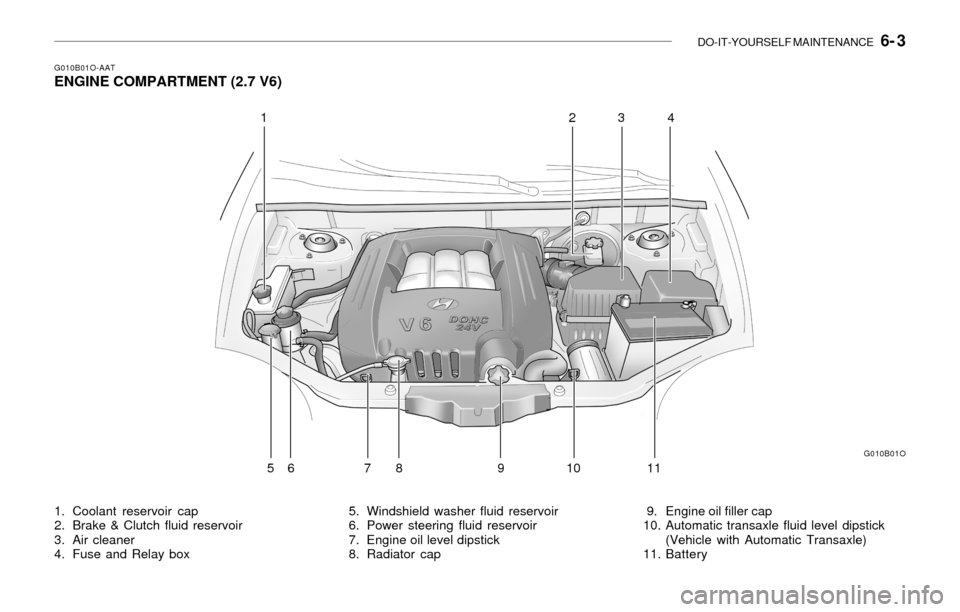
DO-IT-YOURSELF MAINTENANCE 6- 3
G010B01O-AATENGINE COMPARTMENT (2.7 V6)
1. Coolant reservoir cap
2. Brake & Clutch fluid reservoir
3. Air cleaner
4. Fuse and Relay box5. Windshield washer fluid reservoir
6. Power steering fluid reservoir
7. Engine oil level dipstick
8. Radiator cap 9. Engine oil filler cap
10. Automatic transaxle fluid level dipstick
(Vehicle with Automatic Transaxle)
11. Battery
G010B01O
123
4
56 7 8 9 10 11
Page 174 of 221
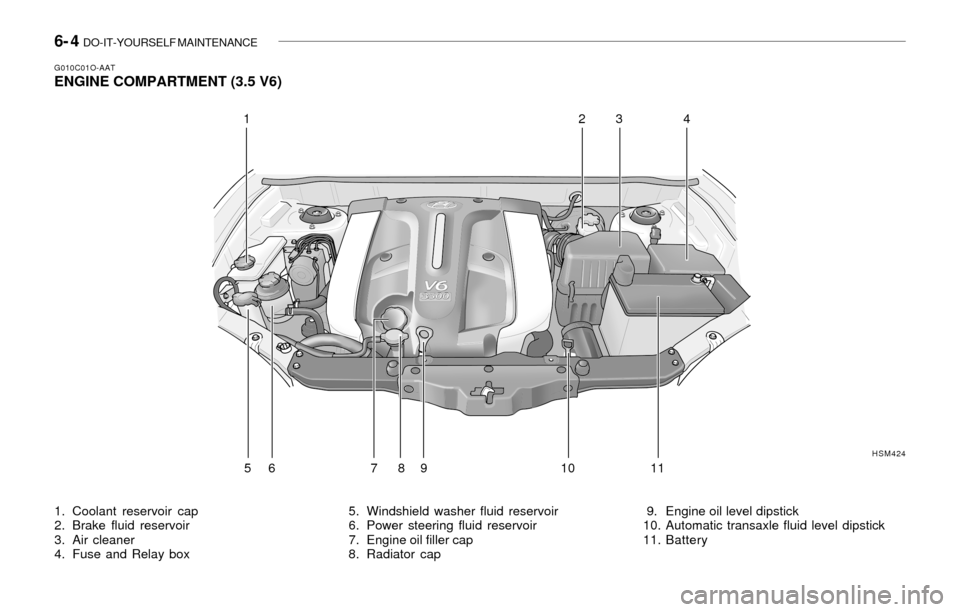
6- 4 DO-IT-YOURSELF MAINTENANCE
G010C01O-AATENGINE COMPARTMENT (3.5 V6)
1. Coolant reservoir cap
2. Brake fluid reservoir
3. Air cleaner
4. Fuse and Relay box5. Windshield washer fluid reservoir
6. Power steering fluid reservoir
7. Engine oil filler cap
8. Radiator cap 9. Engine oil level dipstick
10. Automatic transaxle fluid level dipstick
11. Battery
HSM424
1234
56 7 89 10 11
Page 190 of 221
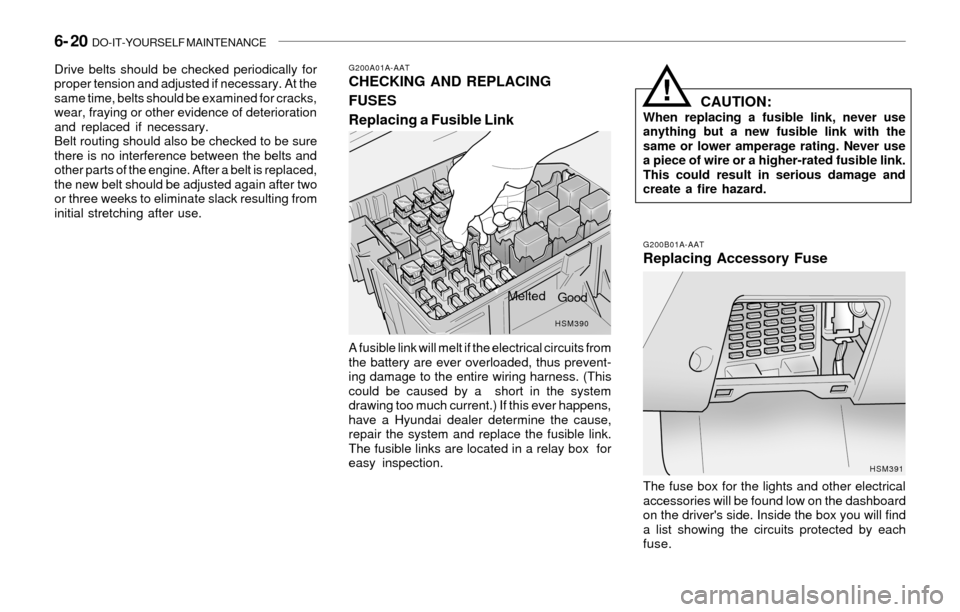
6- 20 DO-IT-YOURSELF MAINTENANCE
!
G200A01A-AATCHECKING AND REPLACING
FUSES
Replacing a Fusible Link
G200B01A-AATReplacing Accessory Fuse
A fusible link will melt if the electrical circuits from
the battery are ever overloaded, thus prevent-
ing damage to the entire wiring harness. (This
could be caused by a short in the system
drawing too much current.) If this ever happens,
have a Hyundai dealer determine the cause,
repair the system and replace the fusible link.
The fusible links are located in a relay box for
easy inspection.
CAUTION:When replacing a fusible link, never use
anything but a new fusible link with the
same or lower amperage rating. Never use
a piece of wire or a higher-rated fusible link.
This could result in serious damage and
create a fire hazard.
The fuse box for the lights and other electrical
accessories will be found low on the dashboard
on the driver's side. Inside the box you will find
a list showing the circuits protected by each
fuse.
HSM390
HSM391
Melted
Good Drive belts should be checked periodically for
proper tension and adjusted if necessary. At the
same time, belts should be examined for cracks,
wear, fraying or other evidence of deterioration
and replaced if necessary.
Belt routing should also be checked to be sure
there is no interference between the belts and
other parts of the engine. After a belt is replaced,
the new belt should be adjusted again after two
or three weeks to eliminate slack resulting from
initial stretching after use.
Page 191 of 221
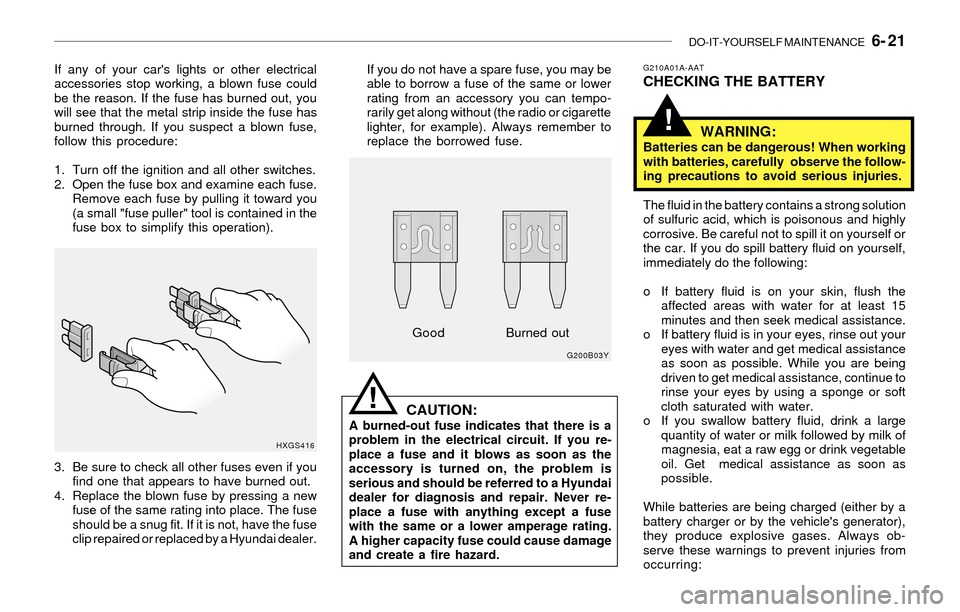
DO-IT-YOURSELF MAINTENANCE 6- 21
!
If any of your car's lights or other electrical
accessories stop working, a blown fuse could
be the reason. If the fuse has burned out, you
will see that the metal strip inside the fuse has
burned through. If you suspect a blown fuse,
follow this procedure:
1. Turn off the ignition and all other switches.
2. Open the fuse box and examine each fuse.
Remove each fuse by pulling it toward you
(a small "fuse puller" tool is contained in the
fuse box to simplify this operation).
3. Be sure to check all other fuses even if you
find one that appears to have burned out.
4. Replace the blown fuse by pressing a new
fuse of the same rating into place. The fuse
should be a snug fit. If it is not, have the fuse
clip repaired or replaced by a Hyundai dealer.
HXGS416
!
If you do not have a spare fuse, you may be
able to borrow a fuse of the same or lower
rating from an accessory you can tempo-
rarily get along without (the radio or cigarette
lighter, for example). Always remember to
replace the borrowed fuse.G210A01A-AATCHECKING THE BATTERY
WARNING:
Batteries can be dangerous! When working
with batteries, carefully observe the follow-
ing precautions to avoid serious injuries.
The fluid in the battery contains a strong solution
of sulfuric acid, which is poisonous and highly
corrosive. Be careful not to spill it on yourself or
the car. If you do spill battery fluid on yourself,
immediately do the following:
o If battery fluid is on your skin, flush the
affected areas with water for at least 15
minutes and then seek medical assistance.
o If battery fluid is in your eyes, rinse out your
eyes with water and get medical assistance
as soon as possible. While you are being
driven to get medical assistance, continue to
rinse your eyes by using a sponge or soft
cloth saturated with water.
o If you swallow battery fluid, drink a large
quantity of water or milk followed by milk of
magnesia, eat a raw egg or drink vegetable
oil. Get medical assistance as soon as
possible.
While batteries are being charged (either by a
battery charger or by the vehicle's generator),
they produce explosive gases. Always ob-
serve these warnings to prevent injuries from
occurring:
CAUTION:A burned-out fuse indicates that there is a
problem in the electrical circuit. If you re-
place a fuse and it blows as soon as the
accessory is turned on, the problem is
serious and should be referred to a Hyundai
dealer for diagnosis and repair. Never re-
place a fuse with anything except a fuse
with the same or a lower amperage rating.
A higher capacity fuse could cause damage
and create a fire hazard.
G200B03Y
GoodBurned out
Page 218 of 221
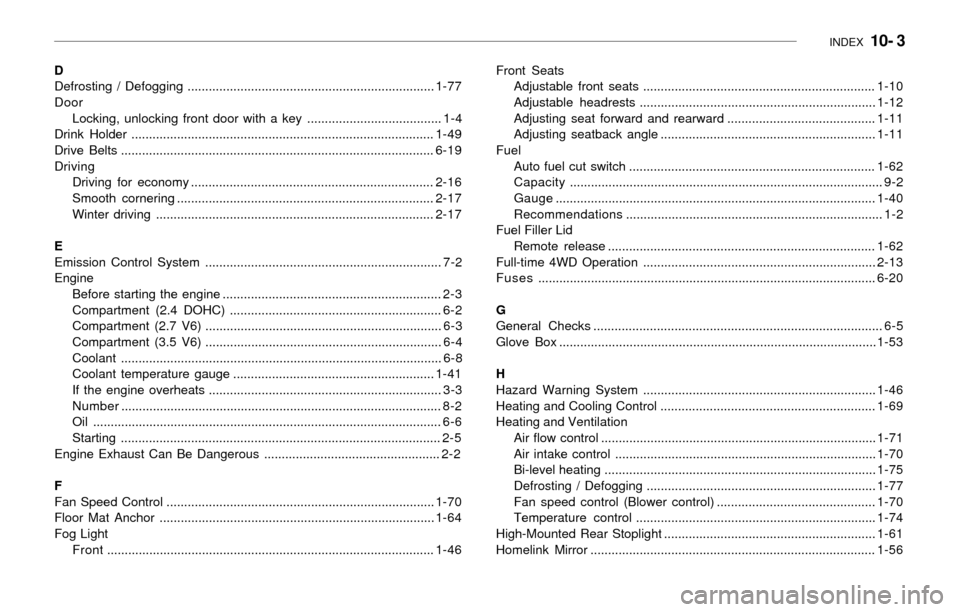
INDEX 10- 3
D
Defrosting / Defogging ......................................................................1-77
Door
Locking, unlocking front door with a key ...................................... 1-4
Drink Holder ......................................................................................1-49
Drive Belts .........................................................................................6-19
Driving
Driving for economy .....................................................................2-16
Smooth cornering .........................................................................2-17
Winter driving ...............................................................................2-17
E
Emission Control System ................................................................... 7-2
Engine
Before starting the engine .............................................................. 2-3
Compartment (2.4 DOHC) ............................................................ 6-2
Compartment (2.7 V6) ................................................................... 6-3
Compartment (3.5 V6) ................................................................... 6-4
Coolant ........................................................................................... 6-8
Coolant temperature gauge .........................................................1-41
If the engine overheats .................................................................. 3-3
Number........................................................................................... 8-2
Oil ................................................................................................... 6-6
Starting ........................................................................................... 2-5
Engine Exhaust Can Be Dangerous .................................................. 2-2
F
Fan Speed Control ............................................................................1-70
Floor Mat Anchor ..............................................................................1-64
Fog Light
Front.............................................................................................1-46Front Seats
Adjustable front seats ..................................................................1-10
Adjustable headrests ...................................................................1-12
Adjusting seat forward and rearward ..........................................1-11
Adjusting seatback angle .............................................................1-11
Fuel
Auto fuel cut switch ......................................................................1-62
Capacity......................................................................................... 9-2
Gauge...........................................................................................1-40
Recommendations......................................................................... 1-2
Fuel Filler Lid
Remote release ............................................................................1-62
Full-time 4WD Operation ..................................................................2-13
Fuses................................................................................................6-20
G
General Checks .................................................................................. 6-5
Glove Box ..........................................................................................1-53
H
Hazard Warning System ..................................................................1-46
Heating and Cooling Control .............................................................1-69
Heating and Ventilation
Air flow control ..............................................................................1-71
Air intake control ..........................................................................1-70
Bi-level heating .............................................................................1-75
Defrosting / Defogging .................................................................1-77
Fan speed control (Blower control) .............................................1-70
Temperature control ....................................................................1-74
High-Mounted Rear Stoplight ............................................................1-61
Homelink Mirror .................................................................................1-56